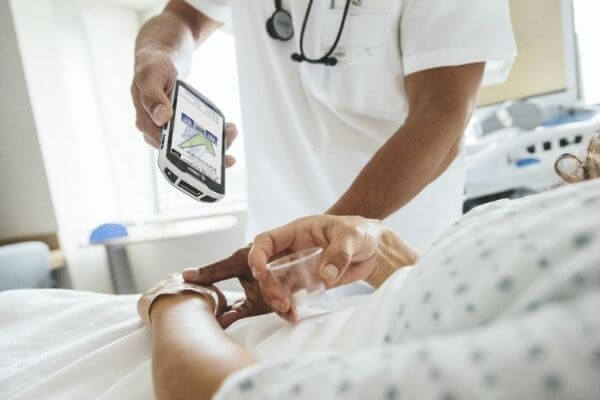With the outbreak of the new coronavirus pneumonia, it is a major disaster for all mankind, and with the development of this epidemic, we also see that the Internet of Things technology has played a huge role in the process of epidemic prevention. The role mainly involves smart logistics, smart retail, infrared temperature measurement, smart medical and other fields.
Medical staff often need to regularly collect patient vital signs information, efficient collection and analysis of vital signs is an important part of hospital information construction. Convenient and effective collection, recording, storage, and query of patient’s sign data will greatly improve the medical diagnosis mode, simplify the hospital nursing process, and improve the management level.
Medical PDA handheld terminal, also called medical handheld RFID data collector, is a data collection, storage and transmission equipment specially created for medical performance management, mobile medical and mobile rounds. Collecting patient, medicine, material information through PDA hand-held terminal, storing relevant information, and transmitting information to the database center in real time with the help of wireless network, you can accurately connect people and things, optimize the information access process to ensure the accuracy and timeliness of data Work efficiency of various departments.
PDA handheld terminal is a kind of fast data collecting intelligent equipment, which integrates payment, inspection, diagnosis, registration and other medical work tasks, realizes intelligent work and management, and becomes an indispensable tool for medical staff.
- Surgery—Preoperative medical staff scan the patient’s wristband barcode through the medical PDA handheld terminal to confirm the patient’s identity; at the same time, scan the patient’s bed barcode to view the patient’s electronic surgery sheet and confirm the surgical information. The operating staff scans the surgical equipment throughthe medical PDA, checks it with the patient and the surgical information, and sends it to the operating room without error. After the operation, the medical PDArecords the operation information and checks the equipment.
- Diagnosis: The medical staff scans the unique identification barcode on the medical record book through the PDA handheld terminal, calls up the patient information table, understands the patient’s previous medical record, and enters more medical information after diagnosis to improve the patient medical record.
- Infusion—The infusion personnel check the patient barcode and the infusion bag barcode through the medical PDA hand-held terminal, and perform infusion to effectively ensure the safety of infusion and prevent infusion errors. The patient can call the infusion staff through the call system, and the call information is transmitted to the PDA handheld terminal of the medical staff in real time, so that the medical staff can go to the treatment in time.
- Registration—The first registration of basic patient information, the medical staff will give the patient a unique identification barcode. By scanning the unique identification barcode during the subsequent registration, the medical staff can track and record the patient information to avoid repeatedly entering the same information.
- Performance management-Through the digital management of mobile devices likePDA handheld terminal, the hospital can also quantify the real-time assessment of the workload of personnel while effectively monitoring the progress of various work, and carry out scientific and effective performance management.
.png)
